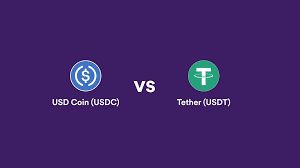
A closer look at the leading stablecoins, their market share, and what it means for traders and institutions in 2025.
Stablecoins are the backbone of today’s crypto market. They bridge the gap between traditional finance and digital assets, providing traders with a reliable unit of account that maintains a $1 peg. Among them, two names dominate the conversation: Tether (USDT) and USD Coin (USDC).
Both are pegged to the U.S. dollar, but their market influence, adoption, and liquidity profiles are very different. If you’ve ever asked yourself which stablecoin is best for trading or liquidity, this article will give you the full picture.
1.Why Stablecoins Matter for Crypto Liquidity
Before comparing USDT and USDC, it’s important to understand why stablecoins matter so much for the crypto ecosystem:
- Trading Pairs – Most exchanges use stablecoins, not fiat, as the base trading pairs. Without them, BTC/USDT or ETH/USDC markets wouldn’t exist.
- Hedging – Traders can move into stablecoins during volatility, preserving value without cashing out to banks.
- Global Accessibility – In countries with unstable currencies, stablecoins provide easier access to U.S. dollars.
- DeFi & Payments – Stablecoins are essential for yield farming, lending, and payments across Web3.
Simply put, stablecoins are the engine of crypto liquidity, without them, the market would slow down dramatically.
2.USDT vs USDC: Stablecoin Market Leaders
Although dozens of stablecoins exist, USDT and USDC together control more than 85% of the market share in 2025, making them the undisputed leaders. Yet, the two are built on very different foundations.
Tether (USDT), launched in 2014 by Tether Limited (affiliated with Bitfinex), is backed by a mix of cash, cash equivalents, and short-term U.S. Treasuries. It has grown into the largest and most liquid stablecoin, though it has often faced criticism for its reserve transparency.
By contrast, USD Coin (USDC) entered the market in 2018, issued by Circle, a regulated U.S. company. Backed primarily by cash and short-term Treasuries with monthly attestations, USDC has built a reputation as the “regulated” and more transparent stablecoin. While it is widely trusted within the U.S. and other compliant markets, its global reach remains smaller compared to USDT.
3.USDT vs USDC: The Numbers (2025 Snapshot)
The stablecoin market cap and trading volume data clearly reveal who dominates liquidity:
- Market Cap (total in circulation):
USDT ≈ $113 billion
USDC ≈ $35 billion
For every $1 of USDC, there are about $3 worth of USDT in circulation.
- Market Share (slice of the stablecoin market):
USDT ≈ 68%
USDC ≈ 21%
Now, think of the stablecoin market as a pizza. USDT holds over two-thirds of the slices, while USDC has only about one-fifth.
- Daily Trading Volume (how much money moves daily):
USDT consistently trades five times more than USDC across exchanges.
This means most liquidity flows through USDT pairs, giving traders tighter spreads and less slippage.
- Adoption Patterns (who prefers what):
USDT → widely used in emerging markets (Nigeria, Turkey, Argentina) as a hedge against inflation and currency controls.
USDC → popular in regulated markets (U.S., Europe), integrated into fintech apps and compliant trading platforms.
Takeaway: In terms of raw liquidity and accessibility, USDT is the undisputed leader, while USDC is the preferred choice for compliance and institutions.
4.Why USDT Dominates Stablecoin Liquidity
Several factors explain why USDT remains the king of stablecoin market share:
4.1 First-Mover Advantage
USDT launched in 2014, giving it a four-year head start before USDC even existed. That early lead helped it dominate exchange pairings and P2P markets.
4.2 Exchange Integration
Nearly every major exchange lists BTC/USDT and ETH/USDT as core trading pairs. This entrenched dominance makes it extremely hard for USDC to displace.
4.3 Adoption in Emerging Markets
In places like Argentina, where inflation is high, or Nigeria, where dollar access is restricted, USDT is a lifeline. Peer-to-peer (P2P) traders and OTC desks heavily rely on it.
4.4 Liquidity Depth
With a market cap over $100 billion and higher trading volume, USDT provides deeper liquidity. For active traders, this means faster execution and smaller spreads.
4.5 Challenges
Tether has had a controversial past. Regulators accused it of not being fully transparent about its reserves. In 2021, it paid fines to U.S. authorities for misrepresenting how its tokens were backed. These issues have made U.S. institutions hesitant, even as USDT continues to thrive overseas.
5.Why USDC Still Matters for the Future.
While USDT dominates trading, USDC plays a strategic role in regulation and trust:
5.1 Regulatory Compliance
Issued by Circle, a regulated U.S. entity, USDC is widely considered the “safer” option for institutions and DeFi protocols seeking transparency.
5.2 Fintech Adoption
USDC integrates with platforms like Coinbase, Stripe, and even traditional payment processors experimenting with digital dollars. This bridges the gap between Web2 and Web3.
5.3 DeFi Preference
Lending platforms and decentralized protocols often prefer USDC as collateral due to its regular attestations and regulatory oversight.
5.4 Potential Regulatory Edge
If the U.S. introduces strict stablecoin regulations, USDC could benefit by already aligning with compliance standards.
5.5 Challenges
The biggest issue for USDC is global reach. While respected in the U.S., it hasn’t spread as widely across emerging markets. With a 2025 market cap of around $35 billion, it’s still only about a third the size of USDT. Its daily volume is also far lower.
6.Now the big question is who really controls liquidity?
If we measure liquidity by market depth, trading volume, and global accessibility, USDT is the clear leader in 2025. Its dominance in emerging markets and global exchange pairs makes it indispensable for most traders.
But liquidity isn’t the only factor. USDC plays a growing role in compliance-driven ecosystems and institutional adoption. Its strength lies in transparency and integration with fintech.
USDT is dominant in liquidity, adoption, and global trading. While, USDC is trusted in compliance, institutions, and DeFi.
Both stablecoins are here to stay, but they serve different user needs in the evolving stablecoin market.
7.Conclusion
Stablecoins will continue to shape the future of crypto liquidity. Right now, USDT holds the crown for global market dominance, while USDC provides a regulated, transparent alternative that could gain traction if U.S. regulation accelerates. For traders, the decision often comes down to what matters most: liquidity or compliance. Either way, both stablecoins will remain at the center of crypto adoption.
Disclaimer: This content is for educational and reference purposes only and does not constitute any investment advice. Digital asset investments carry high risk. Please evaluate carefully and assume full responsibility for your own decisions
Join MEXC and Get up to $10,000 Bonus!
Sign Up

